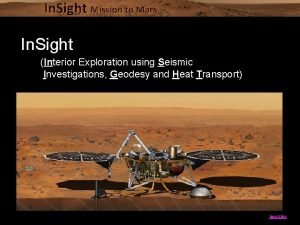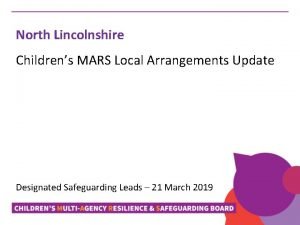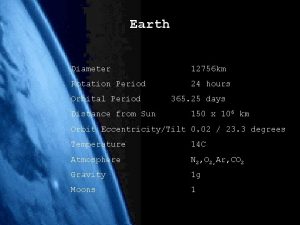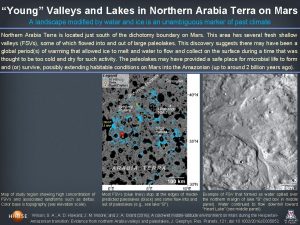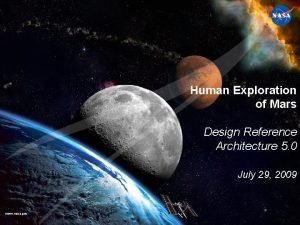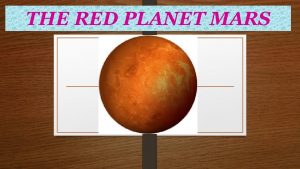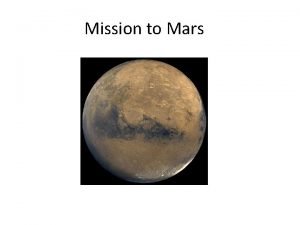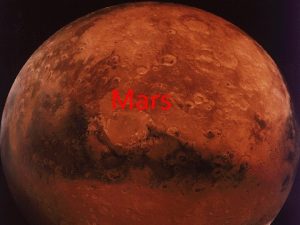What Will It Take To Live on Mars










































- Slides: 42

What Will It Take To Live on Mars? Understanding Martian Resources and Environmental Constraints

Beyond Earth, Mars is one of the only places in the solar system where humans could one day live. In size, Mars is about half the diameter of Earth.

Mars’ surface area is equal to about 1/3 the surface of Earth (about the total area of Earth's continents). That’s a lot of territory! Where will you want to build your community? Natural and human-made resources that are available, along with environmental constraints, will help you decide where and how to live.

Scientists and engineers from all over the world have discovered many environmental and other similarities between Earth and Mars. RADIATION

Mars has many landforms that are familiar to people on Earth. Where is the best place to survive? Olympus Mons Apollinaris Patera Volcanoes?

Gusev Crater Bonneville Crater Impact Craters?

Low, Flat Plains? The rover Opportunity’s heat shield and shadow at Meridiani Planum.

Deep Canyons? Artist’s concept of High View of Melas Valles Marineris To decide on a place where your community will survive and thrive, you’ll want to find the safest place. with the most resources, plus design a few technologies.

For a better life, every Earth community relies on people of all different backgrounds to design solutions to problems. Mars communities will too! Communications Clean Car/Clean Energy Medical Devices Crop Forecasting Environmental Monitoring Advanced Materials for Disaster Relief

Many men and women have chosen science and technology careers to design solutions for a better life on Earth. Sample of NASA Technologies Used in Society

In designing community solutions on Earth, we have to balance natural and human-made resources with environmental and other constraints.

To design a community on Mars, you need to understand how it is different from Earth so that you can balance resources and constraints for your community’s survival there.

The sun is an example of a natural resource that provides power and energy for life systems.

Because of the work of scientists and engineers from all over the world, we know Mars is Earth’s neighbor and the 4 th planet from the sun. Not to scale Since Mars is farther away from the sun, it receives less light than the Earth.

Compared to Earth, Mars is about 1. 5 times farther away from the sun. T H E Not to scale S U N Earth: Sunlight Mars: Reduced Sunlight If you are about twice as far away from the sun, you only have about ¼ the solar energy.

While solar energy is lower for Mars, the sun can still be used as a natural resource for power. Earth: 100% Compared to Earth, the sun’s intensity at other planets is: Jupiter: 4% Mars: 44% Not enough solar power: Saturn: ~1% Uranus: ~ 0. 2% Neptune: ~ 0. 1% Pluto: ~ 0. 06% You may wish to consider other sources to ensure you have enough energy for your community.

For your community to survive and thrive, Hematite (aqueous mineral) on Mars you will also need to identify places with natural resources such as minerals that might be useful to you. Technologies that identify where different minerals are on Mars (in false color above) will be key to include.

Humans depend on Earth’s natural resources for life. Water is one of the most precious of these resources. Water probably flowed on Mars long ago, but no liquid water is on the surface now. Humans will have to find a way to get water to their community on Mars. Nanedi Vallis

Scientists used a technology on the Odyssey spacecraft to discover that Mars has water ice in the ice caps and below the surface in other areas. Your community will need to be near the natural resource water, but since water ice is below the surface, you will have to design technologies to access it.

Food is another resource on which humans depend. The Martian soil is toxic, which is a good example of an environmental constraint. Scientists and engineers around the world have to design a technology for growing food without soil. This technology is called hydroponics.

Compared to Earth, Mars is cold. Temperature is another environmental constraint to be considered in your community planning.

Mars is cold because it is farther from the Sun than Earth, and receives less of the Sun’s warming rays. Also, Mars’ thin atmosphere does not hold much of the heat from the Sun. The extreme temperatures on Mars vary between -190° F and 75° F. 32° F - 184° F How will you stay warm and provide power to your community?

Unlike Earth, Mars’ very thin atmosphere has another big environmental constraint—it does not have enough oxygen for a human to breathe. Digital camera image of Earth’s atmosphere and moon taken by the Columbia Space Shuttle Crew Jan 26, 2003. Artist’s concept of the Mars Reconnaissance Orbiter flying through the martian atmosphere during aerobraking. Oxygen is a basic and necessary natural resource on Earth. Will we have to produce oxygen on Mars? What technologies enable that?

The thin atmosphere means the surface pressure on Mars is 1/100 of Earth. Without a special pressure suit, your organs would push out against your skin.

So, now engineers are researching how to make the best spacesuits to protect human skin and organs. Each new discovery leads to new technologies that must be developed. A protective spacesuit is an example of a human-made resource.

Mars is a dusty place, with a fine reddish-brown or butterscotch-colored soil on the surface. This dust can gunk up spacesuits, jamming the shoulder, elbow, knee and other joints, making movement difficult for people. What can you invent to solve this environmental problem your community must address?

Winds on Mars also blow dust around the surface. Is the wind a potential natural resource you could use or is it an environmental hazard?

The wind can be helpful in cleaning off important equipment such as solar panels and other technologies… but you can’t depend on it being there when you need it. Spirit panoramic camera: March 5, 2005 (left) 416 th martian day, or sol; March 15, 2005 (right), sol 426. These two images show that wind removed dust from the sundial and color calibration target on NASA's Mars Exploration Rover Spirit.

Dust storms often occur in the spring. . . and are sometimes helpful. However, global dust storms can blanket the whole planet, cutting of sunlight and affecting communications with Earth. Springtime North Polar Dust Storm 2002 In winter, frozen carbon dioxide (dry ice) forms on the poles, making the water ice there harder to access.

Therefore, you’ll have to deal with seasonal changes, but watch out! Mars has seasons just like Earth, but they last about twice as long.

Mars’ thin atmosphere and missing magnetic field also allow more of the sun’s harmful radiation to reach the surface than we experience on Earth’s magnetic field Remnants of Mars’ magnetic field Radiation can be considered an environmental constraint to living healthily. How will you protect people from radiation?

World scientists want to know more about radiation on Mars to prepare for human exploration. Earth’s magnetic field Remnants of Mars’ magnetic field So, they worked together with engineers to build the 2001 Mars Odyssey Orbiter to study radiation and other aspects of Mars’ environment.

The Odyssey science team discovered that radiation levels at Mars are twice as high as those in orbit around Earth. How will you solve this big potential health problem for human explorers on Mars?

The good news is that scientists also discovered that lower elevations on Mars have higher levels of natural shielding from radiation. Red = high elevation, low level of shielding Yellow = low elevation, high level of shielding Where will you build your community to encourage its survival?

Scientists are currently researching materials to shield astronauts from radiation. So far, research shows that metals increase radiation levels, while hydrogen seems to shield against it. How will you keep your community members safe?

The pull of gravity on an object on Mars is 1/3 of the pull on the same object on Earth. People will be able to jump higher and lift more on Mars. Even if tasks are easier, will reduced gravity affect human health, and what would help?

Scientific research shows that during long journeys in zero gravity, astronauts lose muscle and bone mass. They must exercise 2 hours a day to stay healthy. How will you keep the first Martian settlers strong during their six-month journey. . . and in a 1/3 gravity environment on Mars?

It’s important, because with the propulsion technologies we now have, it takes a minimum of six months to get to Mars. Earth at arrival Launch 07 -Apr-2001 Yellow Line = Successful route to Mars of the 2001 Mars Odyssey Orbiter Mars Arrival 23 -Oct-2001 Mars at Launch With radio communications technology, it takes a minimum of 4 minutes, and as much as 20 minutes each way depending on where the planets are in their orbits.

Even though Mars is 65 million miles away, we now have the technology to land on its surface. That accomplishment required the talents of men and women from different backgrounds with different skills to contribute.

Thousands of years ago, humans could only see Mars as a red dot in the sky, but now we are exploring with robots. Maybe one day humans will go! The possibility of human communities on Mars will depend on men and women from around the world choosing science and technology careers that will benefit life in communities on Earth first.

What are all of the careers that make a community thrive? How do people in those careers use science and technology to improve their lives? What kind of careers will be needed to make sure your community on Mars survives and thrives?

Because of the work of scientists and engineers, we know more about Mars every day. Someday we may use this knowledge to build safe and thriving communities. . What will your community be like? What do you want to contribute?
 Take a bus or take a train
Take a bus or take a train Go to www.quizlet.live
Go to www.quizlet.live Live healthy be happy
Live healthy be happy Nasa mars
Nasa mars 243 ida
243 ida 2 mars 2006
2 mars 2006 Mars society logo
Mars society logo Pengertian kromosfer
Pengertian kromosfer Mars sight
Mars sight Exo moskwy
Exo moskwy Mars north lincolnshire
Mars north lincolnshire Simile for skyscraper
Simile for skyscraper Mars data analysis
Mars data analysis N mars
N mars Paul's sermon on mars hill
Paul's sermon on mars hill Mars mips tutorial
Mars mips tutorial Nibiru giants
Nibiru giants Vårmåneder
Vårmåneder Wendy mars cisco
Wendy mars cisco Mars radius
Mars radius Mars jupiter and saturn show retrograde motion because
Mars jupiter and saturn show retrograde motion because 3 mars 1947
3 mars 1947 Geography of mars
Geography of mars Tempreture of venus
Tempreture of venus Length of orbit on saturn
Length of orbit on saturn Mars injector
Mars injector Ares mission to mars
Ares mission to mars Mars just play
Mars just play Mars red
Mars red Loi du 5 mars 2007 résumé
Loi du 5 mars 2007 résumé Colestaz
Colestaz Mars
Mars Mars lake
Mars lake Pramuka praja muda karana
Pramuka praja muda karana Exploration sur mars
Exploration sur mars Mars pole
Mars pole Saturnus yttemperatur
Saturnus yttemperatur Surface venus
Surface venus Mars hill speech and debate
Mars hill speech and debate Mars lake
Mars lake Mars bioimaging ltd
Mars bioimaging ltd Orbis epsilon meaning
Orbis epsilon meaning Mittdag i mars
Mittdag i mars








